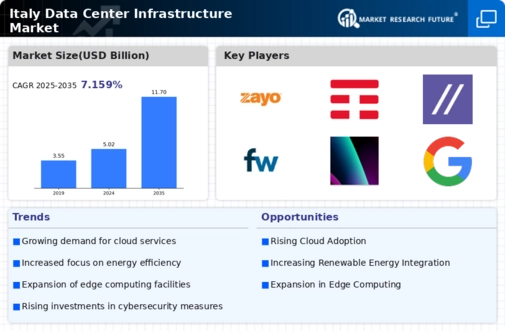Expansion of 5G Networks
The rollout of 5G networks is significantly influencing the data center-infrastructure market in Italy. The enhanced speed and connectivity offered by 5G technology are driving the need for more robust data center infrastructure to support increased data traffic and low-latency applications. As industries such as IoT, smart cities, and autonomous vehicles gain traction, the demand for data centers capable of handling the influx of data generated by these technologies is expected to rise. By 2025, the investment in data center infrastructure to support 5G applications is projected to exceed €2 billion, indicating a substantial opportunity for growth in the market. This expansion necessitates the development of advanced infrastructure that can accommodate the evolving demands of a 5G-enabled ecosystem.
Increased Focus on Data Security
With the rise in cyber threats, the emphasis on data security is becoming a pivotal driver for the data center-infrastructure market in Italy. Organizations are investing heavily in secure infrastructure to protect sensitive information and comply with stringent regulations. The Italian government has implemented various data protection laws, which necessitate robust security measures within data centers. As a result, the market for security solutions, including firewalls, encryption technologies, and intrusion detection systems, is expected to grow significantly. In 2025, spending on data security solutions in Italy is anticipated to exceed €3 billion, reflecting the critical need for secure data center infrastructure to safeguard against potential breaches and ensure compliance with legal requirements.
Rising Demand for Cloud Services
The growing reliance on cloud computing solutions is driving the data center-infrastructure market in Italy. Businesses are migrating to cloud platforms to enhance operational efficiency and scalability. This shift is evident as cloud service providers expand their infrastructure to accommodate growing data storage and processing needs. In 2025, the cloud services market in Italy is projected to reach approximately €10 billion, indicating a robust growth trajectory. As organizations seek to leverage cloud technologies, the demand for advanced data center infrastructure, including servers, storage, and networking equipment, is likely to surge. This trend underscores the necessity for data centers to evolve and adapt to the changing landscape, ensuring they can support the burgeoning cloud ecosystem.
Growing Need for Disaster Recovery Solutions
The rising frequency of natural disasters and unforeseen events is propelling the demand for disaster recovery solutions within the data center-infrastructure market in Italy. Organizations are recognizing the importance of having robust backup systems and recovery plans to ensure business continuity. This trend is leading to heightened investments in data center infrastructure that can support effective disaster recovery strategies. In 2025, the market for disaster recovery services in Italy is expected to reach €1.5 billion, highlighting the critical role of resilient infrastructure in mitigating risks associated with data loss. As businesses prioritize continuity planning, the demand for specialized data center solutions is likely to expand.
Technological Advancements in Infrastructure
Technological innovations are reshaping the data center-infrastructure market in Italy. The adoption of advanced technologies such as artificial intelligence (AI), machine learning (ML), and automation is enhancing operational efficiency and reducing costs. These technologies enable data centers to optimize resource allocation, improve energy efficiency, and streamline maintenance processes. In 2025, the integration of AI and automation in data centers is projected to increase by 30%, indicating a significant shift towards smarter infrastructure. As organizations seek to leverage these advancements, the demand for modernized data center infrastructure that can support such technologies is likely to rise, driving market growth.

























Leave a Comment